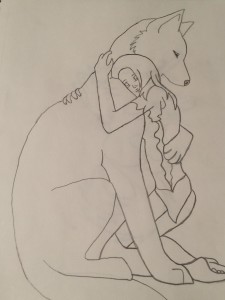This is a picture that my son drew last night (*please read THIS post for an explanation of the gender of the self portrait). A picture really can communicate a thousand words. This one says to me that he is just a lost, scared young person who desperately craves protection and security. And in this picture, it looks like he has begun to find what he needs.
He started art therapy several months ago. It sounded like a great idea, since art is one of his strengths, but I must admit that I was skeptical at first. He has been to several different mental health therapists, with varying results – international adoption family therapy, in-home case management, in-patient psychiatric therapy, and now art therapy.
While each of these services has provided some help and support in crisis, he is often reluctant to talk about unpleasant feelings and topics that stir up his traumatic memories. So I wasn’t sure if art therapy would be any different.
Because of my kiddo’s attachment difficulties and anxiety about being away from me and alone with a stranger, I insisted on being present in all of our sessions. Our first few sessions seemed more like an art class than anything else. The art therapist would give him some materials and demonstrate an art project, and then we would either do the art together or separately.
We had to drive about an hour both ways to get there, so I was still wondering if it was worth all the effort just to do a little craft project and not really TALK about anything much. I was told that the therapy was trauma-focused, and I was hoping that we would start to address and work through his early childhood trauma.
It didn’t look like much “counseling” was going on at all. However, even though what happened in session didn’t seem all that significant, it was what happened in between sessions that started to become transformational for him.
My son loves to draw and is constantly dragging notebooks, pencils, and other art supplies with him in a backpack wherever he goes. After starting art therapy, he began drawing more intensely and almost obsessively. I think that just having those appointments with the art therapist became a reminder to him that art is how he best expresses and processes his deepest feelings.
As a child with delayed language skills (he is deaf and didn’t have full access to sign language until he came home to me at age 10), art is his strongest voice and language. Art therapy was like a spark to his internal creative flame.
Wolves are the subject of his art more often than any other theme. Sometimes, the wolves are ferocious and menacing; while other times, the wolves are loving, playful, or whimsical. Lately, his wolves have been much like the one in the drawing above. Sometimes, the wolf represents God. Sometimes, it is his birth mother. Sometimes, the wolf is me, his adoptive mom.
Always, the wolf represents safety, love, and connection. This picture reminds me a lot of Aslan the Lion from the Narnia series (which he also loves). He definitely has a deep connection with animals, and I believe that this art comes from a very deep place in his heart and soul.
Sadly, the art therapist just informed us that she will be moving out of state in two months. So we are now looking for a new therapist. I’m not sure we will do art therapy again, but we will definitely be taking some drawing and painting classes this summer! He has learned how to use art as a survival skill and it has done so much for his self esteem. It may even become a career some day!
I highly recommend art therapy for any child who enjoys art — especially for kids with trauma that is so hard to express in words.
———————–
Want information on how to become a Trauma-Informed Specialist, Educational Trainer, or Parent Coach? Check out our Trauma-Informed Specialist Certification Program.
